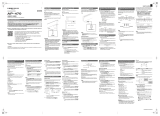
Welcome to the Kawai CA59 digital pianoWelcome to the Kawai CA59 digital piano
10
Important Information
1
Feature Highlights
Grand Feel Compact wooden-key action with Ivory Touch key surfaces and “Let-O” mechanism
The CA59 digital piano utilises Kawai’s latest Grand Feel Compact keyboard action, which draws upon 90 years of acoustic
piano craftsmanship to provide an exceptionally realistic playing experience. All 88 black and white keys are crafted entirely
from long pieces of wood, with nely textured Ivory Touch key surfaces applied to assist playing control.
As with an acoustic grand piano action, the keys rest on a metal balance pin and move with a smooth seesaw-like motion,
while the extended pivot length ensures a consistent, evenly-balanced touch weight – even when playing towards the back
of the key. The Grand Feel Compact action also incorporates grade-weighted hammers, bass region counterweights, and
let-o simulation for added authenticity, while its accurate triple-sensor key detection system allows rapidly repeated notes
such as trills to be performed smoothly, without unnatural breaks in sound.
Shigeru Kawai SK-EX and Kawai EX instruments reproduced with Harmonic Imaging sound technology
The CA59 digital piano captures the magnicent tone of Kawai’s agship Shigeru Kawai SK-EX full concert grand piano.
Widely regarded as the “premier pianos of Japan”, Shigeru Kawai instruments grace the stages of concert halls and musical
institutions throughout the world, and are prized for their exceptional tonal clarity. In addition, the CA59 also features the
distinctive sound of Kawai’s highly acclaimed EX concert grand piano, which has frequently been selected by professional
pianists in such prestigious events as the Chopin, Tchaikovsky, and Rubinstein international piano competitions, among
others.
Both instruments have been carefully recorded, meticulously analysed, and faithfully reproduced with full 88-key sampling
using Harmonic Imaging™ sound technology. This unique process accurately recreates the broad dynamic range of the
original grand pianos, aording pianists an extraordinary level of expressiveness ranging from the softest pianissimo to the
strongest, boldest fortissimo.
Strong selection of additional instrument sounds
Supplementing the realistic acoustic piano voices, the CA59 digital piano also features an excellent selection of additional
instrument sounds, ranging from electric pianos and drawbar and church organs, to strings, human choirs, and even
atmospheric synth-style pads, inviting musicians to add greater variety to their performances.
Furthermore, the Dual playing mode also allows two dierent sounds, such as grand piano and strings, to be layered
together, while the Split and Four Hands modes divide the keyboard into two independent sections. The volume balances
for each playing mode can also be adjusted quickly and easily using the real-time panel controls.
Virtual Technician adjustments to personalise the instrument’s character
The CA59 digital piano’s Virtual Technician feature allows various characteristics of the selected acoustic piano, electric
piano, or harpsichord sound to be shaped at the touch of a button, with settings to adjust voicing and regulation, string,
damper, and cabinet resonances, and subtle hammer, damper, and key release noises. It is even possible to adjust the
precise tuning and volume of individual notes, before storing one’s personalised instrument conguration to memory.
USB to Device functionality, with MP3/WAV le recording and playback
The CA59 digital piano is equipped with USB connectors that not only allow this instrument to be connected to a computer
for MIDI use, but also to load and save data to USB memory devices directly. This “USB to Device” feature allows instrument
settings or recorded songs stored in internal memory to be saved to USB for posterity, or standard MIDI les (SMF)
downloaded from the internet to be conveniently played back without additional hardware.
USB memory devices can also be used to play back MP3 or WAV audio les, allowing musicians to learn the chords or
melody for a new piece, or to simply play along with their favourite songs. It is even possible to record performances as MP3
or WAV les for emailing to friends and family, listening to on the move, or for further editing using an audio workstation.
Integrated Bluetooth® MIDI connectivity
In addition to standard MIDI jacks for connecting to other instruments, the CA59 digital piano also boasts integrated
Bluetooth MIDI and Audio technology that allows the instrument to communicate with supported smart devices wirelessly.
Once connected to a phone, tablet, or laptop, CA59 digital piano owners can enjoy a wide variety of exciting music-related
apps that enhance their learning and playing experience, or stream audio from songs and videos through the instrument’s
speakers without additional cables.
* Availability of Bluetooth function dependent on market location.
Welcome to the Kawai CA59 digital piano





















